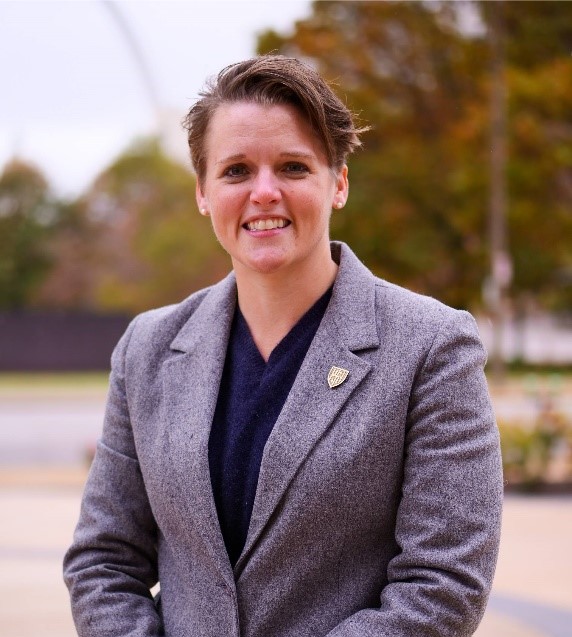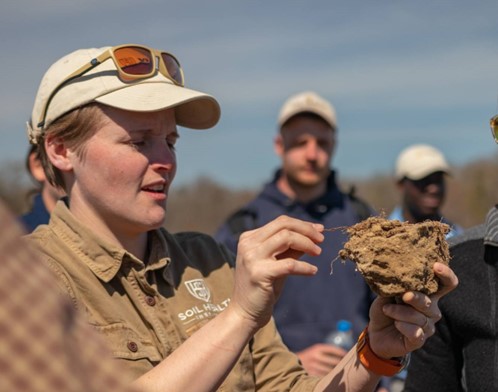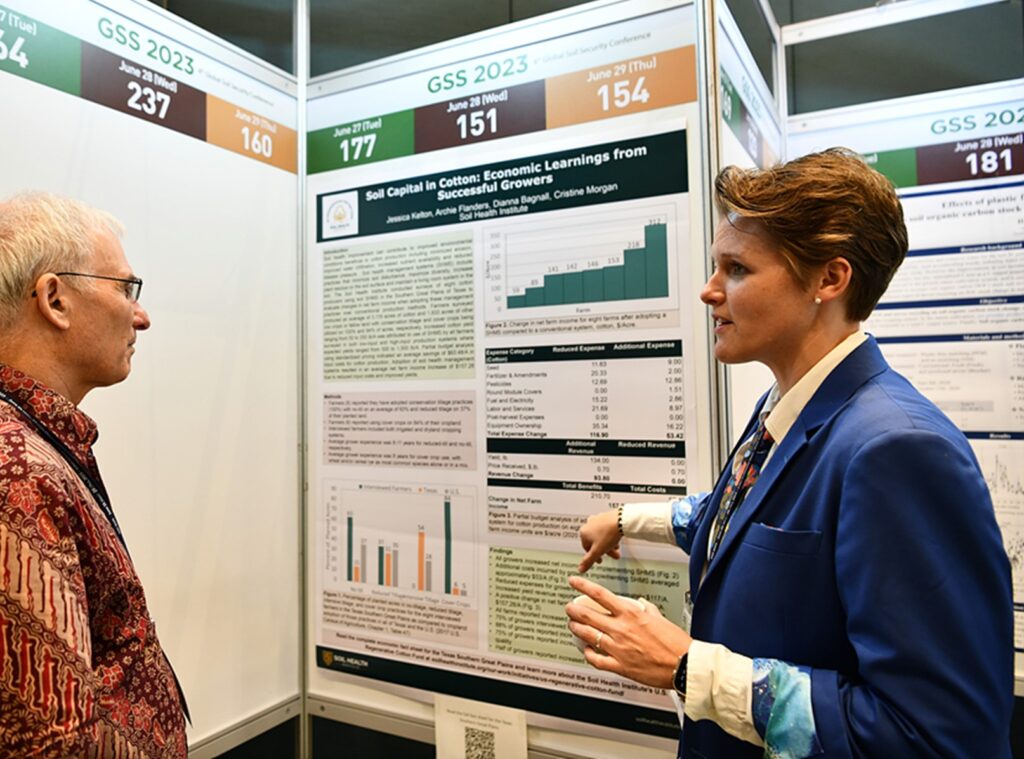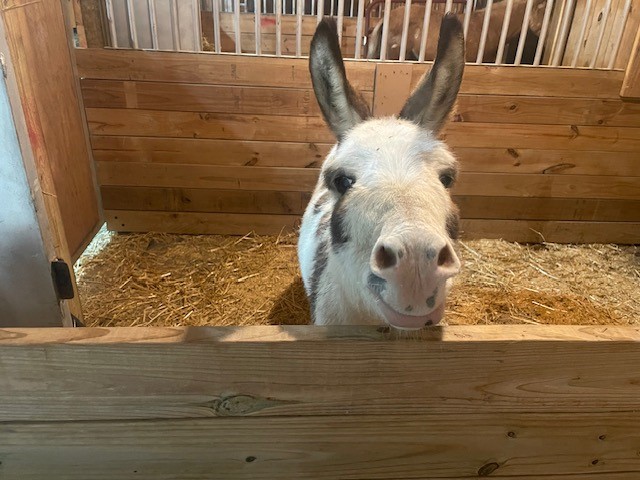
Each year, the American Society of Agronomy gives its Early Career Award to a scientist who has made an outstanding contribution in agronomy within seven years of completing their final degree. This year’s winner is Dr. Dianna Bagnall, SHI Research Soil Scientist and Program Director, who will receive the award at the ASA, CSSA, and SSSA International Annual Meeting in San Antonio November 11.
Here, Dr. Bagnall shares what drew her to soil science, life lessons from mules and afterschool jobs, and learning to see “landscapes underneath landscapes.”
When people outside the field ask what you do, how do you answer?
I say I’m a soil scientist, and then I say the word “dirt” so that they know I didn’t say I was a soul scientist. My Ph.D. did not cover anything metaphysical.
How do people react?
Increasingly over the last 10 years or so, people know what soil is and say, “That’s really cool.” A lot of people link it to food production and some think about soil contamination. Then they ask me what to do about a problem with their tomatoes.
How did you first become interested in soil science?
I had a friend who worked with cattle at a research station and thought, “Oh, that’s with animals, maybe I can do that.” There were no openings on that side of the research, but they needed help in a soil chemistry lab. And the rest is history.
What did you like about soil science?
I initially did not enjoy soil science because I was in a lab. What was really transformational was when I was out doing field work. The scientist I worked for was telling me about these really sandy soils in East Texas where I grew up. They wanted to better understand phosphorus runoff, so they did a rainfall simulation for hours and hours and hours and nothing ran off. These sandy soils just took all of the water. They finally gave up and they packed up their equipment and drove away. When they got to where there was a cutout in the hill, they could see the clay soil exposed with the sand on top of it, and there was all that water that they had been irrigating. It was the first time I could visualize in my head that there were landscapes underneath landscapes. That was a really formative moment.

After getting your master’s and working as a research project manager, what led you to pursue an interdisciplinary Ph.D.?
I just kept realizing how much research was so far away from what companies or organizations were ready to act on. And I thought of my own research, how I used to say, “I’m running this hydrology model that farmers could use,” but it was written in Fortran and there was no graphical user interface. I realized that not only will farmers not use it, other researchers don’t even want to put up with this. It was that desire to take knowledge from our academic systems and move it into actionable outcomes for society and the environment that led me to want to pursue natural resource economics – so, rural sociology and soil science – which is what I did my Ph.D. in.
You did a lot of farmer interviews as part of your Ph.D. What were some of your big takeaways?
A big one was humility in the number of things that growers have to juggle. When we start our conversations without knowing where that person is coming from, not only is it not going to be successful, but it can be offensive and lead to them having a bad interaction with scientists and then saying, “Well, these folks don’t really care about me.” People sometimes characterize farmers as risk-averse, but for the growers I’ve been able to work with, that’s really not been true. They’re not going to change over everything in the operation tomorrow, but they’re probably more willing to experiment than the average person.
How does that experience inform your work at SHI?
It’s about really trying to keep the end user in mind. That posture of humility has really carried over in saying, “Here’s what we’re able to say. We hope that it’s helpful to you, but we don’t want to be prescriptive and overstate what we know about your operation.”

What has been some of your most rewarding work at SHI?
Getting to be part of the development of a new set of pedotransfer functions for plant available water. While right now it’s primarily out there for soil scientists to use, we’re leveraging that work to be able to inform growers all across the continent about how much water they might be able to save in their operations for their crops if they were to adopt soil health management practices. And that’s only possible because we have that strong link to the data collected in the North American Project to Evaluate Soil Health Measurements. It’s really consistent with the philosophy of doing good science and applying it to help people see what could happen if they change their management practice. I don’t know of any place I could be doing such interdisciplinary research with such a strong soil science emphasis and also be able to focus on the outreach component too.
Did you grow up farming?
I did not, but I did grow up gardening about two acres and raising livestock. Today I’m kind of a hobby farmer. I have two mules, one miniature donkey, one horse, three German Shepherds, two cats, and a couple of fish.

What are you passionate about outside of work, and how does it inform the work that you do at SHI?
Mules. Mules are incredibly important. My love of agriculture and being on the land ties in really strongly with my work at SHI. It’s very humbling as a land manager, even of only six or seven acres, to think about some egghead Ph.D. wanting me to not have any erosion in a spot that I have to get across with a manure spreader every day. Sometimes we have to put things in that human context.
Your teen job “Stock Worker and Cashier at Nick’s Deli” appears on your CV. What life lessons did you learn there?
I had three hours to clean and stock the store, and that was so incredibly hard. The intensity that was needed to get that done was not something I had experienced in my life before and it seemed absolutely impossible. I remember going home from my first day of work thinking, “There’s no way this amount of work can get done.” But it did. When we’re confronted with something that does not seem doable, if we stick with it, we can do it, whether it’s stocking a store or publishing a paper. It’s about not letting that initial moment of uncertainty or concern convince you that it’s impossible.